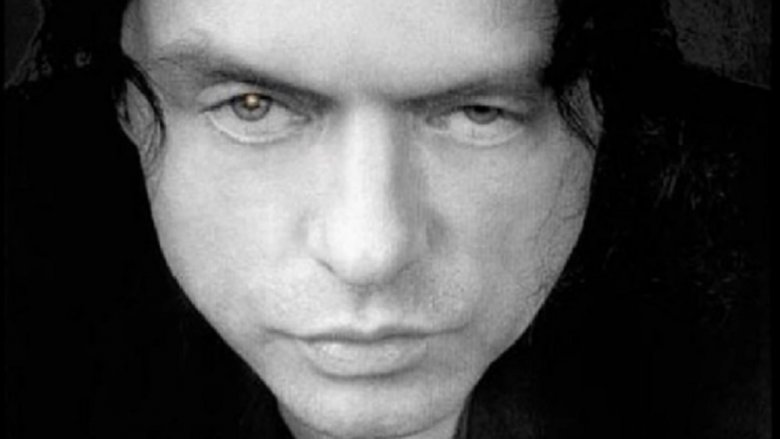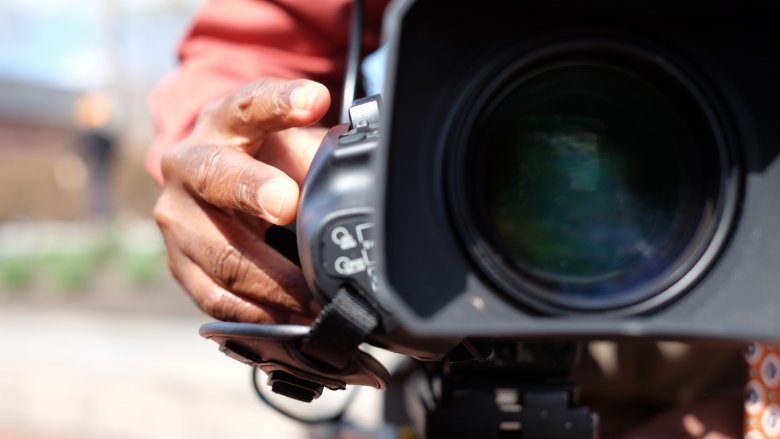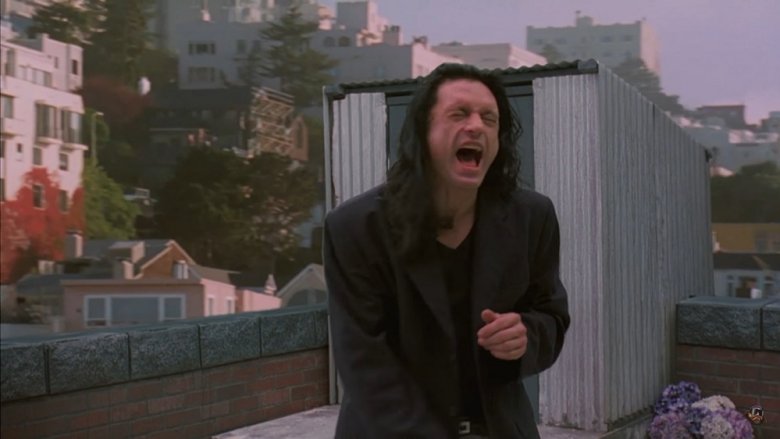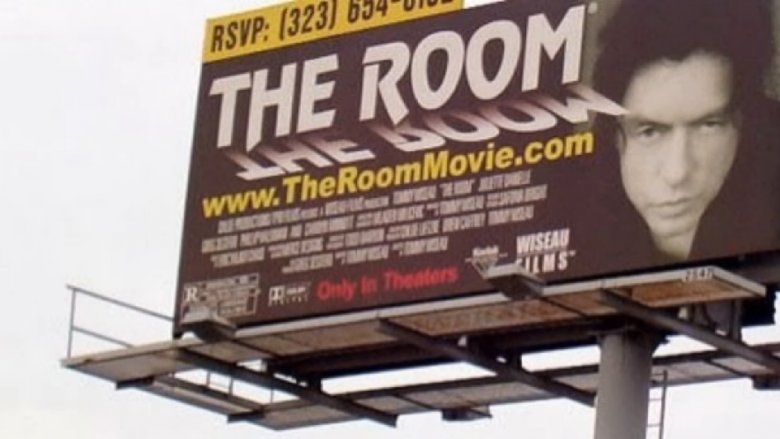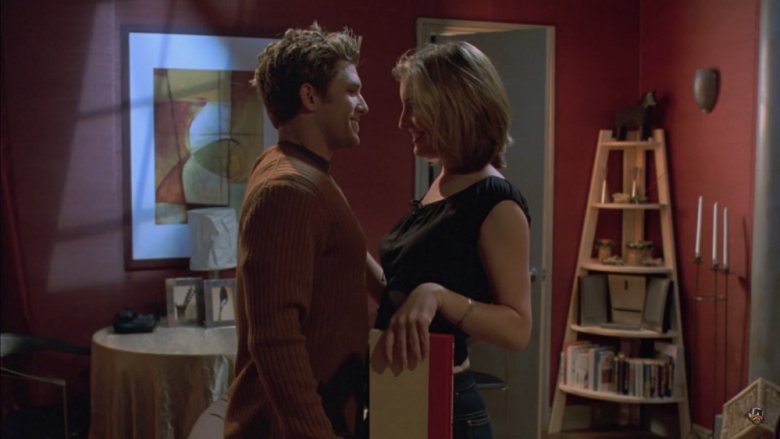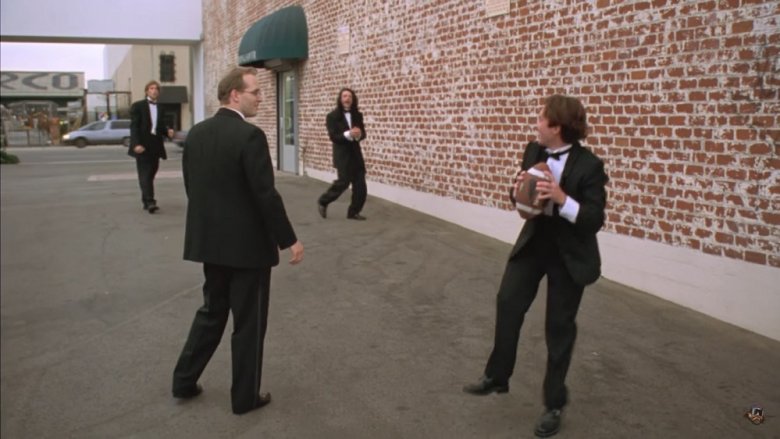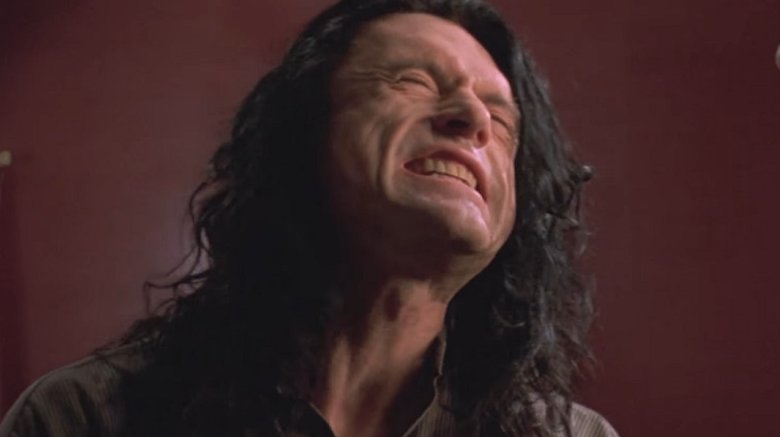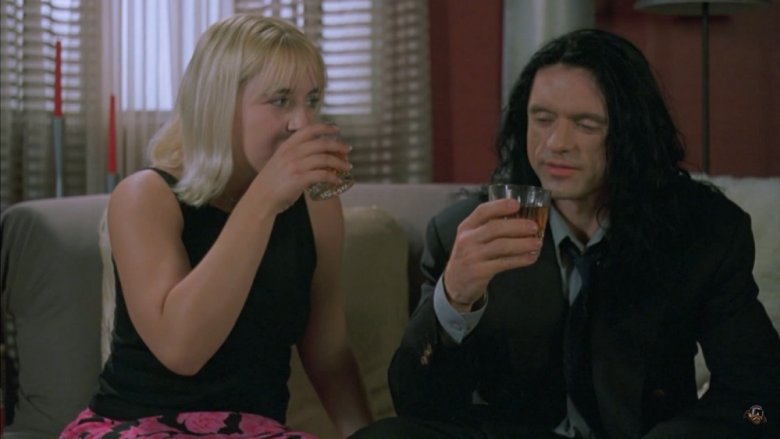The Untold Truth Of The Room
If you're not familiar with Tommy Wiseau's anti-masterpiece The Room, you're doing yourself a serious disservice. Released in 2003, the film known as the Citizen Kane of bad movies has attracted an enormous following because of its singularly bizarre nature—it's a work of stunning incompetence, playing as though it were made by aliens based on bad second-hand information about filmmaking, relationships, and human beings in general.
The story of how The Room came to be is as weird as the film itself. Enigmatic writer/producer/director/star Tommy Wiseau willed it into existence with six million dollars and the help of several hundred extremely confused friends and collaborators, employing a process that could generously be described as "haphazard." The end result must be seen to be believed—and these bizarre facts about this eminently bizarre film will make your viewing all the more hilarious.
Nobody knows where Tommy Wiseau came from
Hollywood has seen more than more than its fair share of eccentric personalities, but none quite like Tommy Wiseau. He radiates an odd charisma, but his speech patterns and accent suggest someone who just recently arrived on this planet. For all anybody knows, this might be accurate. Nobody has ever been able to pin down his place of origin, where or even if he went to film school, or his age—and Wiseau himself tends to answer such questions in highly abstract terms.
He's told interviewers that he's a "forty-something" who was born in France "a long time ago," and at least the last part is probably correct. For one thing, his accent doesn't sound the least bit French, but vaguely Eastern European, and in 2014, one Redditor claimed to have found evidence that he's actually a Polish immigrant. As to his age, most online bios say he was born in 1968, which would have made him 35 at the time of The Room's release—although the IMDb lists his birthdate as October 3, 1955. Wiseau disputes this, but won't reveal his true age.
The film's financing is also a mystery
If you consider only what's actually onscreen, it's tough to figure out where exactly The Room's $6 million budget went. The cheap locations, shoddy greenscreen work and limited action don't offer much of a clue, but an even bigger mystery is where the funds actually came from. Wiseau allegedly financed the production out of his own pocket, and if he's to be believed, he managed to save the entire amount selling knockoff leather jackets.
"I tell you a little bit, but that's it," he cagily responded when Entertainment Weekly asked about his funding. "We import from Korea the leather jackets that we design here in America. If you work, you have to save money, right? I didn't get money from the sky. I was preparing, let's put it this way." This obviously explains next to nothing, unless the reference to getting money from the sky was a slip of the tongue: one admittedly silly fan theory suggests Wiseau is actually D.B. Cooper, the infamous hijacker who jumped out of a plane with thousands of dollars in 1971 and disappeared.
It was shot in two formats
Despite it not showing up onscreen, the budget actually did go somewhere. The Room may have been one of the most needlessly wasteful productions in film history, as illustrated by the fact that Wiseau apparently didn't know that most shoots are done with rented cameras and equipment. As a result, not only did he purchase the equipment outright, he bought the most expensive component twice.
Wiseau was unclear on the relative merits of 35 millimeter film versus high-definition video, so rather than seek out advice or do research, he simply bought one of each camera. He then had a custom rig built so the film could be shot in both formats at once. In case you're unaware, professional cameras of this type can cost anywhere from $10,000 to $100,000 or more—and not a single frame of the digital footage was used in the final product.
The shoot was as ridiculous as the film
In addition to the needless spending, the production had a cast and crew that was ridiculously deep. The six-month shoot—longer than your average Marvel film—took place on an L.A. soundstage and employed 400, and each actor in the cast had multiple understudies, which is really more of a theater thing. Not only this, but due to butting heads with Wiseau, the entire crew was replaced no fewer than four times. Fortunately, the cast didn't have quite as much turnover—they were only replaced three times.
Production delays weren't the only reason for the insanely long shoot. Wiseau's dialogue was so clunky that the entire cast struggled with it, and none more mightily than Wiseau himself. During an infamous rooftop scene, his character Johnny enters, rambling to himself about his girlfriend Lisa's abuse accusations before noticing his friend and conversationally blurting out "Oh hi, Mark." Lead actor Greg Sestero recounts that Wiseau wrestled so hard with the substance and timing of the lines that after countless takes, filming had to be paused because the cameraman was laughing hard enough to shake the camera. But Wiseau's lack of on-camera experience didn't deter him from trying to cram in more sex for Johnny whenever possible—the film's aggressively un-erotic ten minutes of sex scenes would have been double that length had Wiseau not listened to reason from cast and crew.
Its promotion was... unique
The Room's unconventional advertising campaign must also have eaten up a good portion of the budget, albeit over a long period of time. Rather than rely on print, television or the internet, Wiseau opted for a huge billboard, erected at a prominent Highland Avenue location in Los Angeles. The billboard's image, the same one featured on the film's poster, is one Wiseau calls "Evil Man"—a black and white closeup of his face with one eye partially closed. Despite the striking image, which may have led some to believe The Room was a horror movie, the film grossed only about $12,000 during its opening weekend.
The apparent failure of the advertising strategy seemed to escape Wiseau completely. He continued to shell out $5,000 a month to keep the billboard up for five years—long enough for it to become something of a tourist attraction. Wiseau gave a typically scrambled answer when asked how he could afford it: "Well, we like the location, and we like the billboard. So we feel that people should see The Room... (and) we are selling DVDs, which are selling okay."
It didn't begin as a movie
Amazingly, The Room began life as a gargantuan novel authored by Wiseau sometime in the mid-'90s, with the idea for adapting it into a feature film not coming along until later. Wiseau has claimed that his script for The Room was "based on 600-800 pages of the book"—which was never published, but surely would have been a mind-shattering read.
This incarnation wasn't the only stop on the way to feature film immortality, however. Having a background in theater, Wiseau's next idea was to adapt the story into a Broadway stage play, and a version of this original script from 2001 actually does exist. Several local theater companies across the U.S. have mounted stage adaptations of the film, and Sestero has showed off this early script at some of these presentations. It opens with a hefty helping of word salad: "This play can be played without any age restriction. It will work if the chemistry between all the characters makes sense. Human behavior and betrayal applies to all of us. It exists within ourselves. You love somebody. Do you? What is love? "
The title made sense at one point
Many fans have pointed out an obvious fact that gets lost in the film's absurdity: its title makes no sense. Many of its scenes take place in the same apartment, but the action is by no means limited to one room, and plenty of scenes take place outdoors or in other locations. But during the time the project was in development as a stage play, all the action was indeed supposed to take place in a single room. Wiseau has since said that the title is supposed to evoke a "safe space" for viewers, but Sestero insists he was simply too lazy to change the title, which sounds slightly more plausible.
Sestero has also stated that in the transition from stage to screen, a great deal of insanity which would have made the project unfeasible for either medium was cut out. This, it is alleged, was largely due to the efforts of one man—a man who may be more responsible for the finished product than Wiseau himself.
Wiseau may not have actually directed
Sandy Schklair officially held the title of Script Supervisor on The Room. This usually entails keeping an eye out for continuity errors to ensure, for example, that an actor isn't holding a cup that mysteriously disappears during a cut to a different angle. But according to Schklair and others, his job became a lot more involved—up to and including basically taking over as director.
Schklair told EW that Wiseau asked him to "tell the actors what to do, and yell 'Action' and 'Cut' and tell the cameraman what shots to get," which is a succinct summary of a director's duties, and that actors would approach him in a panic asking him to rewrite scenes so that they made sense. He confirmed many fans' suspicions by elaborating, "Tommy never, ever, ever, ever saw the humor that we were throwing into it... I would go home and scream with laughter, because he just did not know what was happening at all."
This was confirmed by at least one anonymous cast member, who said, "The script supervisor ended up sort of directing the movie... Tommy was so busy being an actor that this other guy directed the whole thing." Wiseau vehemently denies this and points out that Schklair left the production before the end of principal photography, to which Schklair countered: "I had been offered a position working as a script supervisor with Janusz Kaminski. I could spend my day shooting Tommy's naked ass, or go work with a DP with two Oscars."
The main character might have been a vampire
The world may never know the extent of the craziness that existed in the script before Schklair (allegedly) stepped in, but we can gain some insight into the type of material Wiseau thought would be appropriate for his character-driven drama. Having a lifelong fascination with vampires, he at one point got it into his head that there should be a mid-film plot twist revealing Johnny to be one of the bloodsucking undead, despite a great deal of the film taking place during the daytime. This big twist would have been accomplished, of course, by revealing that Johnny has a flying car.
Setting aside the fact that vampires and flying cars have nothing to do with each other, it can be argued that this unexpected direction may have at least made the film a bit more exciting. Perhaps unfortunately, the flying car sequence was deemed too expensive by the crew (presumably with a great deal of faux disappointment), and the idea was scrapped.
The Disaster Artist
Many of these behind the scenes anecdotes have only come to light publicly because of Sestero's bestselling 2013 book The Disaster Artist: My Life Inside The Room, co-written with journalist and author Tom Bissell. Wiseau's buddy, confidant and leading man paints a picture of a typical driven, controlling artist with a severely atypical complete lack of understanding of his chosen craft, compounded by his utter unawareness of his own shortcomings. Still, Sestero retains an obvious fondness for his book's subject, saying he sees the story of The Room's production as inspirational—and Hollywood, strangely, agreed.
In early 2017, SXSW saw the premiere of The Disaster Artist, an adaptation starring James Franco (who also directed) as Wiseau. Wiseau, who didn't "support Greg's book one hundred percent," had a change of heart when Hollywood came knocking, telling iNews he was flattered at the thought of being portrayed by Franco—"a cool guy"—and he even ended up doing a brief cameo in the film. Asked about his work's continued popularity, he offered an amazingly thoughtful response.
"I think there's something invigorating about watching someone take a creative risk with their vision, and then watch that risk breed a complete disaster," mused Wiseau. "There's an entertainment value in that which is seemingly more enjoyable than watching a basic, well constructed film that follows a safe path."
